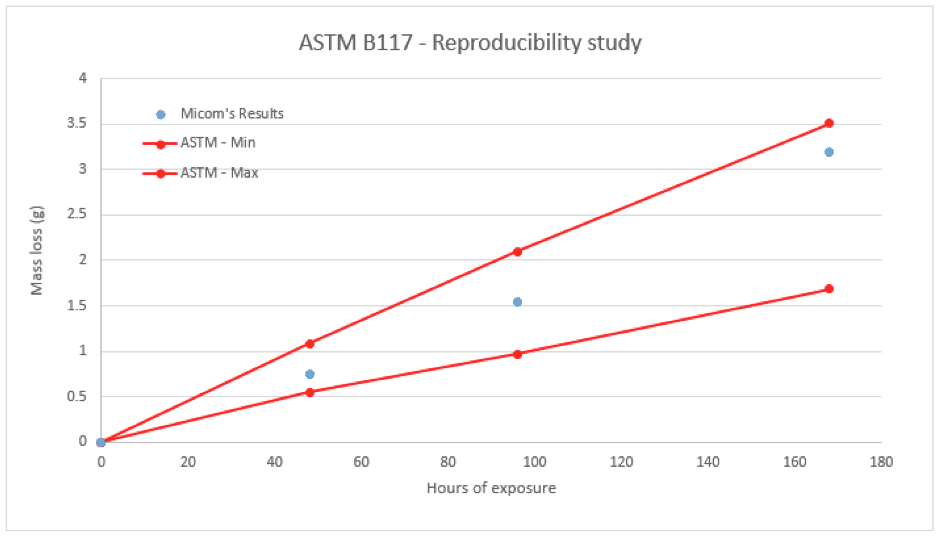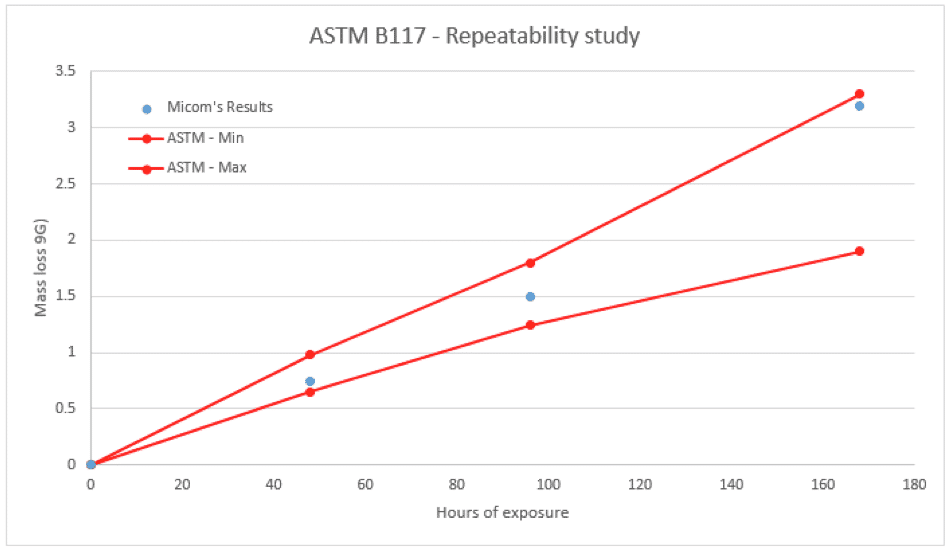ASTM B117 Testing Quality Control
ASTM B117 Testing
ASTM B117 Testing, also known as a Standard Practice for Operating Salt Spray (Fog) Apparatus, is used to analyze relative corrosion for specimens of metals and coated metals exposed to various simulated climatic conditions in a controlled environment. This testing practice was initially published in 1939 and rapidly gained worldwide acceptance across all major industry segments.
ASTM B117 Testing requires controls over many operational parameters such as:
- Fog atomization rate: 1.0-2.0 ml/hour
- Cabinet internal temperature 35 +/- 2 oC
- pH range: 6.5-7.2
- Salt concentration: 5 +/- 1%
If all of these parameters are set within the specifications, your corrosion tests should produce meaningful results. However, it is an act of faith. At Micom, we always promote good laboratory practices and we test reference materials of known characteristics to insure that overall the test equipment is generating reliable test results. Such verification is possible for ASTM B117. Indeed in Annex X3 of the ASTM Document – “EVALUATION OF CORROSIVE CONDITIONS” a procedure is given “for evaluating the corrosive conditions within a salt spray cabinet”[1]. Furthermore ASTM B117 Document states “the procedure involves the exposure of steel test panels and the determination of their mass losses in a specified period of time.
Annex X3 specifies the test panels to be used with their dimensions and alloy grade (UNS G10080). It also includes a pre-test and a post-test chemical cleaning procedure for the panels. A total of 3 control panels are used for exposure durations of 48, 96 and 168 hours. Upon chemical cleaning and drying the panels are weighted to 1/10000th of a gram (0,0001g). Annex X3 also contains repeatability and reproducibility statistics that can be used by laboratories as acceptance criteria for validating their salt spray testing cabinet.
These testing procedures allow testing labs to insure their test results are in line with the expected performance of a proper ASTM B117 testing protocol. Below you will find a reproducibility study done by our corrosion testing laboratory based on the ASTM B117, annex X3 requirements:
Reproducibility Study: ASTM B117 Testing – Operating Salt Spray (Fog) Apparatus
| Study Date: | January 2014 | ||
| Salt Spray chamber used: | MI-EQ-477 – Model CTT 1100 – 13-1152-40 | ||
| Panels used: | UNS G10080 steel plates 76 x 127 x 0.8 mm | ||
| Data source: | ASTM B117-11 X3.8 Precision and Bias – Steel Panel Test | ||
The ASTM reproducibility study gives the acceptable limits (with a 95% reproducibility limit) on the consistency of mass loss results from different labs and cabinets.
Reference data:
The statistical data used below are from the precision and bias ASTM study detailed in ASTM B117-11 « Operating Salt Spray (Fog) Apparatus ».
Table 1: ASTM[2] reproducibility study

Table 2: Micom results

Table 3: Comparison – Mass loss (Micom vs. ASTM study)

Note 1: R = 2.8 x SR
Table 4: Comparison – Coefficient of variation (Micom vs. ASTM study)

Note 2: CV (%) = 100 x (SR / ṁ)
Graphic representation

Conclusion:
Micom results are within ASTM B117 acceptable corrosion rates.
Repeatability Study: ASTM B117 Testing– Operating Salt Spray (Fog) Apparatus
| Study Date: | January 2014 | ||
| Salt Spray chamber used: | MI-EQ-477 – Model CTT 1100 – 13-1152-40 | ||
| Panels used: | UNS G10080 steel plates 76 x 127 x 0.8 mm | ||
| Data source: | ASTM B117-11 X3.8 Precision and Bias – Steel Panel Test | ||
The ASTM repeatability study gives the acceptable limits (with a 95% reproducibility limit) on the consistency of mass loss results from panels tested simultaneously in a cabinet.
Reference data:
The statistical data used below are from the precision and bias ASTM study detailed in ASTM B117-11 « Operating Salt Spray (Fog) Apparatus ».
Table 1: ASTM[2] repeatability study
Table 2: Micom results

Table 3: Comparison – Mass loss (Micom vs. ASTM study)

Note 3: Each result from the ASTM study is the average of 2 steel panels tested simultaneously. Each result from Micom’s study is also the average of 2 steel panels tested simultaneously in the same cabinet.
Note 4: r = 2.8 x Sr
Table 4: Comparison – Coefficient of variation (Micom vs. ASTM study)

Note 5: CV (%) = 100 x (Sr / ṁ)
Graphic representation
Conclusion: Micom’s results meet ASTM B117 testing requirements for precision and bias of corrosion rates.
Please note that this Quality Control process is currently not available for ASTM G85 test. However we are developing a set of data that could be used for this test method.
For more information about ASTM B117 testing or additional corrosion testing, we invite you to contact us . It will be our pleasure to answer your questions.
If you like to download the ASTM B117 PDF version of this article, please view the presentation below
This article is a preview of the Corrosion Testing white paper that we are currently working on and that will be available in the following months. If you would like to be notified when our white paper on corrosion comes out, we invite you to send us an email.
Disclaimer
All of the information and opinions contained in this blog are made with the information, and the understanding that we have reviewed at the time of publishing. However, despite our efforts, we do not offer any guarantee of their accuracy, thoroughness of our investigation or validity. The author of this blog is not liable for any inaccuracies or any losses or damages that may result from the use of the information or data contained herein. This blog has not been reviewed or verified for its accuracy by any peer group associates prior to publication.
[1] ASTM International, ASTM B117-11 Standard Practice for Operating Salt Spray (Fog) Apparatus.
[2] The largest ASTM testing study (data from 12 cabinets) was used as reference.




